Jan Dismas Zelenka
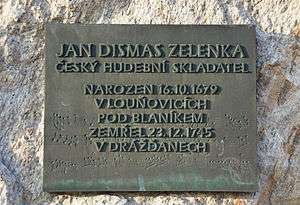
Jan Dismas Zelenka (baptised Jan Lukáš Zelenka; 16 October 1679 – 23 December 1745),[1] also known as Johann Dismas Zelenka, was a Czech composer and musician of the Baroque period. His music is admired for its harmonic inventiveness and counterpoint.
Life
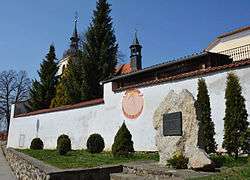
Zelenka was born in Louňovice pod Blaníkem (German: Launiowitz), a small market town southeast of Prague, in Bohemia. He was the eldest of the eight children born to Marie Magdalena (née Hájek) and Jiří Zelenka. The middle name Dismas is probably his confirmation name.[2] Zelenka's father Jiří was a schoolmaster and organist in Launiowitz, and it is likely that Zelenka received his musical lessons with him. However, nothing more is known with certainty about Zelenka's early years. He received his musical training at the Jesuit college Clementinum in Prague.[3] His instrument was the violone (or bass viol). His first works were probably written in Prague, and his earliest known work Via laureta (ZWV 245) was composed in 1704. The music is lost, but a libretto still exists.
Zelenka served Baron von Johann Hubert von Hartig in Prague, before his appointment as violone player in Dresden's royal orchestra.[4] This Baron von Hartig was a well known connoisseur of music and a virtuoso musician. He corresponded with many important Italian composers and amassed a great musical library in his life, which Zelenka would later have access to, as in the example of Antonio Lotti's Missa Sapientiae. In ca. 1729 Zelenka copied this work from Hartig's collection, and later in the 1730s, Johann Sebastian Bach acquired a copy of Lotti's mass from Zelenka's library. Georg Friedrich Handel's copy of Lotti's mass might also have been acquired through Zelenka. When Johann Hubert died in Prague in 1741, Zelenka dedicated his Litaniae Lauretanae 'Salus infirmorum' (ZWV 152) to his old patron.
It is possible that Count Johann Hubert von Hartig recommended Zelenka for the Dresden Hofkapelle (court orchestra) as a double bass player. Zelenka entered the service of the Dresden court with a salary of 300 thalers in 1710/1711. The favourable conditions for music making at Dresden gave added impetus to his creativity, particularly with respect to the composition of sacred music for the Catholic court church.[2] His first opus in Dresden was a Mass, the "Missa Sanctae Caeciliae" (c. 1711).[5] Zelenka must have made an impression with his music, for only few months after his arrival in Dresden his salary was increased by 16,6 %, to 350 thalers, which placed him amongst the better paid musicians in the Hofkapelle. Three years later, Zelenka's salary was increased once again, this time by 14,3 %, which raised his wages to 400 thalers.
Zelenka continued his education in Vienna under the Habsburg Imperial Kapellmeister Johann Joseph Fux beginning in 1716; he was back in Dresden by 1719. Whether or not he ever went to Venice is unclear, but a Saxon court document of 1715 records a royal cash advance for such a journey to Zelenka along with fellow composers Christian Petzold and Johann Georg Pisendel. New documents concerning the arrival of Petzold and Pisendel in Italy have now surfaced. Since Zelenka was not travelling with his colleagues, it now seems very unlikely that he made the trip to Venice.[6]
Except for an extended stay in Prague in 1722-1723, where Zelenka conducted the première of one of his major secular works, Sub olea pacis et palma virtutis conspicua orbi regia Bohemiae Corona, a melodrama about St. Wenceslas on the occasion of the coronation of Charles VI, he remained in Dresden.[7] While in Prague he concentrated on instrumental composition, as the autograph of the score of Concerto à 8 concertanti confirms: "Six concerti written in a hurry in Prague in 1723".
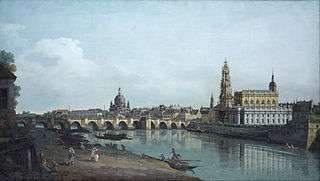
In the early 1720s Zelenka composed some of his finest works, for example the Responsoria pro hebdomada (ZWV 55) and the Lamentations (ZWV 53). As a result, his compositions now formed an important part of the repertory of the Catholic court church. Following the frequent illnesses of Kapellmeister Johann David Heinichen, Zelenka gradually took over the direction of the sacred music. In January 1726 Zelenka began to register his own works, and compositions of other composers he collected, into his Inventarium (1726-1739), which today is one of the most important documents of Dresden baroque music. Heinichen died in July 1729, and Zelenka became the acting Kapellmeister, a position that he fulfilled in an unofficial capacity until 1734. This period is known as the Interregnum in the literature, a term coined by Professor Wolfgang Horn.[8] The first work that confirms Zelenka's newly-found status is the Sinfonia (ZWV 190, 18 May 1729, previously known as Capriccio), which, as Janice B. Stockigt has now established, was performed at a Galla event to celebrate the birthday of the Saxon Elector and Polish King, August II.[9] The official publication Königl. Polnischer und Churfürstl. Sächsischer Hoff- [Hof- from 1734] und Staats-Calender, which listed the members and servants of the Dresden court, shows Zelenka listed as a Contra-Basso & Compositeur, in the editions of 1731 and 1732: in 1733 he is listed as a Compositeur only, which clearly suggests that he no longer was playing the double-bass. Instead, Zelenka most likely directed the sacred music from his position as a singer.[10]
The period of the Interregnum has given birth to a number of outlandish theories on Zelenka's position at the Dresden court, and especially around his petitions from October/November 1733 for the Kapellmeister position. The fact is, that already before Heinichen died in 1729, the Dresden court was actively looking for a well-established opera composer to take Heinichen place. This was a part of a long-term project to re-establish the opera in Dresden. From 1724 the Dresden court had been training five young Italian opera singers with some of the finest vocal teachers in Italy, and these teachers included Nicola Porpora. In the first week of February 1730, the young singers, the castrati Domenico Annibali (alto), Giovanni Bindi and Ventura Rocchetti 'Venturini' (sopranos), and the sisters Maria Rosa Negri and Anna Negri (sopranos) were called to Dresden. There is no coincidence that in the same week, Johann Adolph Hasse was offered the "primo" Kapellmeister position – meaning that he was to be the first and most senior Kapellmeister. These two events were clearly connected with each other.[10]
Following the arrival of the five young singers in Dresden in April 1730, Zelenka would play an important role in their continuing education. After the "compositeur de la musique italienne" Giovanni Alberto Ristori travelled to Moscow in the end of 1730, Zelenka became responsible for supplying secular vocal music for the chamber concerts for the court at the royal palace in Dresden. It is at this point in time when he began to assemble his fascinating collection of Italian operas and cantatas, which partly still exists in Dresden and are individually numbered in the hand of Zelenka. This suggest that he once held an inventory of the secular works in his possession: by listing up the numbers it was possible to reconstruct Zelenka's now missing inventory. This included a number of arias of Hasse, who had arrived in Dresden in July 1731 with his famous wife, Faustina Bordoni-Hasse, the most brilliant female singer of the baroque era. Shortly after his arrival Hasse was officially appointed Kapellmeister: it was a position he was to reign in unrivalled and unchallenged for the next 32 years. After the performances of his opera Cleofide in September 1731, Hasse and Faustina travelled back to Italy, but not before the future arrangements of the Hofkapelle had been decided and later put in motion. Johann Georg Pisendel was officially appointed Konzertmeister. Eleven new musicians were hired for the orchestra on 28 November 1731. On that same day, Zelenka was awarded a handsome salary increase of 37,5 %, which brought his wages up to 550 thalers. This enabled Zelenka to purchase 24 opera arias and one duet, eight secular cantatas and two sacred motets from Antonio Vivaldi, music he was then able to use both in the chamber and the church.[11]
After August II died in Warsaw on 1 February 1733, his son and successor as Saxon Elector Friedrich August moved swiftly, and tied Hasse and Faustina to an extraordinary contract, worth an astonishing 6000 thalers annually, in addition to travel costs. At that time, Hasse was already one of the most famous composers in Europe and it was a major coup for the Dresden court to have secured his and Faustina's services. Confirmation of Hasse's position is seen in the libretto to his Siroe, which was performed in Bologna in May 1733, where the composer is titled Maestro di Cappella di S.A. R. l’Elettore di Sassonia. In that same month, Zelenka was also referred to as the elector's "well-born and virtuoso Kapellmeister" in a letter written by the Superior of the Catholic court church in Dresden.
Following the election of Friedrich August as King of Poland (as August III) in October 1733, countless servants from all departments of the Dresden court sent in petitions for unpaid salaries or promotions. Zelenka was one of those who petitioned. It was only natural for the composer to wish to attain official recognition from the newly elected Polish king. The impression has often been given in the literature that Zelenka was in direct competition with Hasse for the Kapellmeister position. Nothing is more far from the truth. It was very clear to Zelenka at that time, that his colleague Hasse was, and would remain the senior Kapellmeister.[12] As it turned out, Hasse, like he did in 1750, requested that he alone would hold this title. This led the Dresden court to create the official position of church composer, which Zelenka would hold from 1734 and onwards, in the good company of his student Tobias Buz and, from November 1736, Johann Sebastian Bach.
J.S. Bach held Zelenka in high esteem, as evidenced by a letter of 13 January 1775 from his great son C.P.E. Bach to Bach biographer Johann Nikolaus Forkel. Zelenka was actually a guest in Bach's Leipzig home at one point. Bach thought enough of Zelenka to have some of his works copied; e.g. he had his eldest son, Wilhelm Friedemann, copy out the Amen from Zelenka's third Magnificat (ZWV 108) for use in Leipzig's St. Thomas's church where J.S. Bach was cantor for the last 2 1/2 decades of his life.[3]
In addition to composing, Zelenka taught throughout his life, instructing a number of prominent musicians of that time, e.g. Johann Joachim Quantz (Frederick the Great of Prussia's longtime court flautist and flute teacher), and J. G. Roellig. His close friends included eminent composers Georg Philipp Telemann, Johann Georg Pisendel and Sylvius Leopold Weiss.

Zelenka died of dropsy in Dresden on December 23, 1745, and was buried on Christmas Eve.[7] He never married and had no children; his compositions and musical estate were purchased from his beneficiaries by Electress of Saxony and Queen of Poland Maria Josepha of Austria, and after his death were considered valuable court possessions. Telemann, with Pisendel's assistance, tried unsuccessfully to publish Zelenka's "Responsoria". He wrote on 17 April 1756, with undisguised contempt for publishers' disinterest in the work, that "the complete manuscript will be at the Dresden court, kept under lock and key as something very rare...".
There is no confirmed portrait of Zelenka, but worthy of mention is a mirror-image black-and-white copy of a well-known portrait of his old teacher Fux which has been passed off as a picture of Zelenka on several respected websites.
Musical style
Zelenka's pieces are characterized by very daring compositional structure, with a highly spirited harmonic invention and perfection of the art of counterpoint. His works are often virtuosic and difficult to perform, but always fresh and surprising, with sudden turns of harmony, being always a challenge for their interpreters. In particular, his writing for bass instruments is far more demanding than that of other composers of his era. His instrumental works (the trio sonatas, capricci, and concertos) are exemplary models of his early style (1710s–1720s). The six trio sonatas demand high virtuosity and expressive sensitivity from performers. As Zelenka was himself a violone player, he was known to write fast-moving continuo parts with driving and complicated rhythm.
Zelenka was aware of the music in different regions of Europe. He wrote complex fugues, ornate operatic arias, galant-style dances, baroque recitatives, Palestrina-like chorales, and virtuosic concertos. Zelenka's musical language is closest to Bach's, especially in its richness of contrapuntal harmonies and ingenious usage of fugal themes. Nevertheless, Zelenka's language is idiosyncratic in its unexpected harmonic twists, obsession with chromatic harmonies, huge usage of syncopated and tuplet figures, and unusually long phrases full of varied musical ideas. He is sometimes considered as Bach's Catholic counterpart, in his works.
Zelenka's music is influenced by Czech folk music. In this respect, he continues the tradition of the production of specific Czech national music, initiated by Adam Michna z Otradovic and brought to its culmination later, in works by Bedřich Smetana and Antonín Dvořák in the nineteenth century and Leoš Janáček and Bohuslav Martinů in the twentieth century.
In 2013 Damian Thompson wrote of Zelenka, "He belongs to a band of mavericks in musical history whose experiments with harmony seem to catapult them into another generation".[13]
Rediscovery
The rediscovery of Jan Dismas Zelenka's work is attributed to Bedřich Smetana, who rewrote some scores from the archives in Dresden and introduced one of the composer's orchestral suites in Prague's New Town Theatre festivals in 1863.
It was mistakenly assumed that many of Zelenka's autograph scores were destroyed during the fire-bombing of Dresden in February 1945. However, the scores were not kept in the Katholische Hofkirche but in the basement of the Japanese Palace, north of the river Elbe. Some are certainly missing, but this probably happened gradually – and the lost scores represent only a small proportion of his extant works.
Interest in Zelenka's music has begun to grow, especially since the end of the 1950s. By the late 1960s and early 1970s all Zelenka's instrumental compositions and selected liturgical music were published in Czechoslovakia. The most important revival was demonstrated by the first presentation of selected compositions by Czech conductor Milan Munclinger and his ensemble Ars Rediviva. They were three trio sonatas in 1958–60, Sinfonia concertante in 1963 and the exquisite interpretation of "Lamentationes Jeremiae prophetae" with soloists Karl Berman, Nedda Casei and Theo Altmeyer in 1969. The music of Zelenka has become widely known and available since that time, through recordings and sparked the interest of musicians such as, Milan Munclinger (above), Heinz Holliger and Reinhard Goebel.
More than half of Zelenka's works have now been recorded, mostly in the Czech Republic and Germany. Such recordings include the masses Missa Purificationis, Missa Sanctissimae trinitatis, Missa votiva, Missa Sancti Josephi, and his secular works "Sub olea pacis" and "Il Diamante", mostly performed by new Czech ensembles using original instruments and interpretational techniques of the Baroque era - above all Musica Florea, Collegium 1704, Ensemble Inégal, and Capella Regia Musicalis.
In honor of Jan Dismas Zelenka, "The Autumn Music Festival under Blaník" (Podblanický hudební podzim in Czech) was founded in 1984. Since then, performances of Zelenka's music have regularly taken place in and around his birthplace.
Works
Zelenka's complete compositions are listed in Wolfgang Reich's thematic catalogue Jan Dismas Zelenka: Thematisch-systematisches Verzeichnis der musikalischen Werke (ZWV)[14] ("Systematic thematic catalogue of musical works") and in Janice Stockigt's monograph Jan Dismas Zelenka: A Bohemian Musician at the Court of Dresden.[15]
The total number of Zelenka's known and attributed opus numbered works is 249. Sacred vocal-instrumental music is at the center of his compositions, and include over 20 masses, four extensive oratorios and requiems, two Magnificats and Te Deum settings, 13 litanies, many psalms, hymns, antiphons. Zelenka also wrote a number of purely instrumental works – six trio or quartet sonatas, five capricci, one "Hipocondrie" as well as Concertos, Overtures and Symphonies.
Sacred music
The most appreciated of Zelenka's sacred works are probably his masses, above all his Missa Purificationis (ZWV 16, his last mass to include brass instruments) and his final five pieces (ZWV 17–21), commonly called "High Mass" compositions, written between 1736 and 1741 and considered as Zelenka's compositional peak. The last three were also called "Missae ultimae" (Last Masses). The following list contains only the most important sacred works, that have been sufficiently explored to date.
Masses and requiems
- Missa Sancti Spiritus
- Missa Sancti Josephi
- Missa Purificationis Beatae Virginis Mariae
- Missa Sanctissimae Trinitatis
- Missa Votiva
- Missa Dei Patris
- Missa Dei Filii
- Missa Omnium Sanctorum
- Requiem in C Minor
- Requiem in D Minor
Oratorios
- Il Serpente di Bronzo
- Gesù al Calvario
- I penitenti al sepolchro del Redentore
Litanies
- Litaniae de Venerabili Sacramento
- Litaniae Lauretanae
- Litaniae Lauretanae "Consolatrix afflictorum"
- Litaniae Lauretanae "Salus infirmorum"
- Litaniae Omnium Sanctorum
- Litaniae Xaverianae
Psalms and hymn settings
- Dixit Dominus
- Confitebor tibi Domine
- In exitu Israel
- Lauda Jerusalem
- Laudate pueri
- Ave maris stella in D Minor
- Chvalte Boha silného
- Ave Regina coelorum
- Regina coeli
- Salve Regina
- De Profundus (Psalm 130)
Other liturgical and spiritual works
- Te Deum in D Major (2 settings)
- Magnificat in C Major and D Major
- Miserere in D Minor and C minor
- Lamentationes Ieremiae Prophetae
- XXVII Responsoria pro hebdomada
Secular works
Zelenka composed only a few extensive vocal-instrumental pieces on secular themes, but one of them – Sub olea pacis et palma virtutis--Melodrama de St. Wenceslao (1723) – not only represents one of the high points in baroque music, but transcends it, as with many others of Zelenka's works. It is a monumental opus with aspects of melodrama, oratory and contemporary opera, composed for the coronation of Charles VI by the Czech king and celebrating the memory of the greatest Czech saint and patron of Bohemia, prince St. Wenceslaus (Václav), one of the founders of the Czech state.
Vocal-instrumental works
- Sub olea pacis et palma virtutis (conspicua orbi regia Bohemiae Corona – Melodrama de Sancto Wenceslao)
- Il Diamante
- 8 concert arias ZWV 176 (5 for soprano, 2 for alto and 1 for bass)
Instrumental works
- Trio or Quartet Sonatas Nos. 1–6
- Capriccios Nos. 1–5
- Concerto à 8 Concertanti
- Hipocondrie à 7 Concertanti
- Overture à 7 Concertanti
- Simphonie à 8 Concertanti
Selected discography
- Orchestrální skladby – Overture, ZWV 188, Sinfonia concertante, ZWV 189, Ars Rediviva, Martinů Chamber Orchestra, 1963, LP, Supraphon
- Lamentationes – abbreviated version of "Lamentationes Ieremiae prophatae", Ars Rediviva (Milan Munclinger), 1969, LP, Supraphon
- The Orchestral Works – Camerata Bern, 3 CDs, 1989, Universal
- Trio Sonatas 1–6, 2 CDs, 1993, Studio Matouš
- Missa Sanctissimae Trinitatis, Musica Florea (Marek Štryncl), CD, 1994, Studio Matouš
- Requiem In D Minor; ZWV 48, Miserere In C Minor; Psalm 50, ZWV 57, CD, 1995, Supraphon
- Magnificat, ZWV 108; De profundis, ZWV 96; Litaniæ Omnium Sanctorum, ZWV 153, Salve Regina, ZWV 137) – Czech Philharmonic Orchestra and chorus, CD, 1998, Supraphon
- Missa Dei Patris – Barockorchester Stuttgart, Kammerchor Stuttgart (Frieder Bernius), CD, 2001, Carus
- Sub olea pacis et palma virtutis – Musica Florea, Musica Aeterna, Ensemble Philidor, Boni Pueri (Marek Štryncl), 2 CDs, 2001, Supraphon; world premiere recording
- Gesù Al Calvario – Das Kleine Konzert, Rheinische Kantorei (Hermann Max), CD, 2001, Capriccio
- Lamentations Of Jeremiah – Chandos Baroque Players, CD, 2002, Helios
- Complete Orchestral Works – Das Neu-Eröffnete Orchestre (Jürgen Sonnentheil), 3 CDs, 2002, CPO
- I penitenti a sepolcro del Redentore, Capella Regia Musicalis (Robert Hugo) & soloists, incl.mezzo-soprano Magdalena Kožená, CD, 2004, Supraphon
- I penitenti a sepolcro del Redentore ZWV 63, Collegium 1704, Collegium Vocale 1704 (Václav Luks), CD, 2009, Zig-Zag Territoires
- Missa Dei Filii, Litaniae Laurentanae "Salus Infirmorum" – Taffelmusik (Frieder Bernius), CD, 2004, Deutsche Harmonia Mundi
- Missa Dei Patris in C major, ZWV 19 – Virtuosi Saxoniae (Ludwig Güttler), CD, 1990, Berlin Classics
- Composizioni per orchestra – Collegium 1704 (Václav Luks), CD, 2005, Supraphon
- Il serpente di bronzo – Ensemble Inégal (Adam Viktora), CD, 2005, Nibiru
- Missa purificationis Beatae Virginis Mariae – Ensemble Inégal (Adam Viktora), CD, 2007, Nibiru
- Missa votiva ZWV 18 – Collegium 1704, Collegium Vocale 1704 (Václav Luks), CD, 2008, Zig-Zag Territoires
- Il Diamante (Serenata ZWV 177), Ensemble Inégal, Prague Baroque Soloists (Adam Viktora), 2 CD, 2009, Nibiru
- Missa Sancti Josephi ZWV 14, Litaniae Xaverianae ZWV 155 – Ensemble Inégal, Prague Baroque Soloists (Adam Viktora), CD, 2010, Nibiru
- Officium Defunctorum ZWV 47 / Requiem ZWV 46, Collegium 1704 / Collegium Vocale 1704 (Václav Luks), 2 CDs, 2011, Accent (Note 1 Musikvertrieb)
- Sepolcri ZWV 58–60. Collegium Marianum, Jana Semerádová, Praha 2011, Music from Eighteenth-Century Prague
- Missa Omnium Sanctorum ZWV 21, Barbara dira effera ZWV 164, Christe eleison ZWV 29 - Ensemble Inégal, Prague Barogue Soloists (Adam Viktora), CD, 2011 Nibiru
- Sonatas – Ensemble Marsyas with Monica Huggett, SACD and digital download, 2012, Linn Records
- Missa Sanctissimae Trinitatis ZWV 17, Gaude laetare ZWV 168 - Ensemble Inégal, Prague Baroque Soloists (Adam Viktora), CD, 2012 Nibiru
Gallery
The Zelenka memorial in Louňovice pod Blaníkem, Czech Republic includes a 2012 sundial to mark the 333rd anniversary of his birth. Graphic design and painting is by Milan Houdek, text by Vladimír Hirsch: "Tempus fugit - opus permanens est" (above), "Ad honorem artis tui, ad gloriam Dei et patriae petentis".
 Memorial
Memorial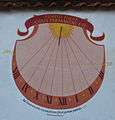 Sundial
Sundial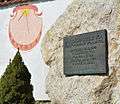 Memorial with sundial
Memorial with sundial
References
- ↑ Slonimsky, Nicolas (1978). "Zelenka, Jan Dismas". Baker's Biographical dictionary of musicians. (6th ed.). New York: Schirmer Books. p. 1940. ISBN 0-02-870240-9.
- 1 2 David Charlton: Jan Dismas Zelenka, a detailed biography at Classical Net
- 1 2 "Jan Dismas Zelenka". bach-cantatas.com. 2008. Retrieved 2010-07-18.
- ↑ Václav Kapsa – Jana Perutková – Jana Spáčilová: Some remarks on the relationship of Bohemian aristocracy to Italian music at the time of Pergolesi, in: Giovanni Battista Pergolesi e la musica napoletana in Europa centrale (Studi pergolesiani – Pergolesi studies 8), ed. C. Bacciagaluppi, H.-G. Ottenberg and L. Zoppelli, Bern, Peter Lang, 2012, pp. 315-316.
- ↑ Lo Mejor De La Musica Clasica
- ↑ Janice B. Stockigt, Zelenka Reviewed and Re-evaluted, paper given at the Zelenka Conference Prague, 15 October 2015.
- 1 2 Jan Dismas ZELENKA, biography at baroquemusic.org
- ↑ WOLFGANG HORN, Die Dresdner Hofkirchenmusik 1720-1745: Studien zu ihren Voraussetzungen und ihrem Repertoire, Kassel, Bärenreiter – Stuttgart, Carus, 1987, p. 89.
- ↑ JANICE B STOCKIGT, On the Dresden Sources of Zelenka’s Instrumental Music, “QUCOSA”, forthcoming.
- 1 2 , p. 31. Jóhannes Ágústsson, The Secular Vocal Collection of Jan Dismas Zelenka – A Reconstruction, in "Studi vivaldiani" 13, 2013, pp. 3-52: p. 31.
- ↑ Ibid, pp. 38-40.
- ↑ JANICE B. STOCKIGT and JÓHANNES ÁGÚSTSSON, The Visit of Members of the Dresden Hofkapelle to Bautzen, forthcoming.
- ↑ Thompson, Damian (27 July 2013). "Why has nobody heard of the miraculous Czech composer Zelenka?". The Spectator. Retrieved 2013-07-27.
- ↑ Jan Dismas Zelenka: thematisch-systematisches Verzeichnis der musikalischen Werke (ZWV)
- ↑ Janice B. Stockigt: Jan Dismas Zelenka – A Bohemian musician at the court of Dresden, Oxford University Press
Sources
External links
-
 Media related to Jan Dismas Zelenka at Wikimedia Commons
Media related to Jan Dismas Zelenka at Wikimedia Commons - The "Discover Zelenka" website, which includes a database of works and recordings. (It is even possible to get an up-to-date list of unrecorded works).
- The Zelenka Forum
- Jan Dismas Zelenka Detailed Biography of classical.net
- Wolfgang Reich's catalog of Zelenka's works
- Janice Stockigt: Jan Dismas Zelenka: A Bohemian Musician at the Court of Dresden
- Jan Dismas Zelenka (www.bach-cantatas.com)
- Discography
- Music on Net
- Free scores by Jan Dismas Zelenka at the International Music Score Library Project
- Free scores by Jan Dismas Zelenka in the Choral Public Domain Library (ChoralWiki)